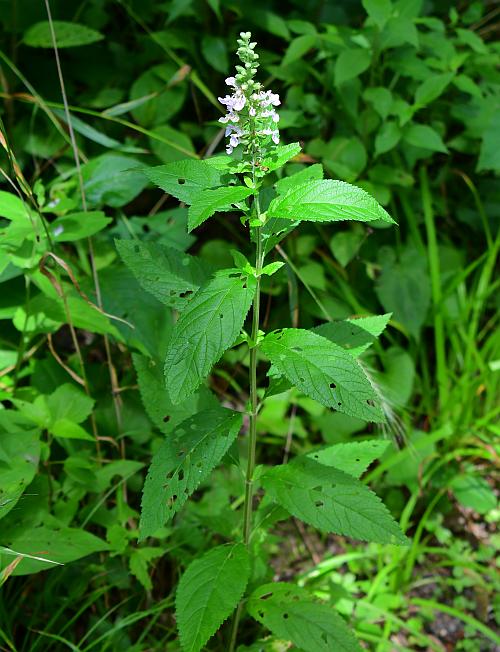Teucrium canadense L.
American Germander

Native
CC = 2
CW = -3
MOC = 99
© SRTurner
Teucrium canadense L.American Germander | |
 |
Native CC = 2 CW = -3 MOC = 99 |
© SRTurner |
|
Family - Lamiaceae Habit - Rhizomatous perennial forb, sometimes also producing tubers, often colonial. Stems - Strongly ascending to erect, to 1.2 m, 4-angled, unbranched or few-branched, moderately to densely pubescent with short, downward-angled hairs and sometimes also with longer, spreading hairs.
Leaves - Opposite, sessile or petiolate. Blades 3-12 cm long, 1-5 cm wide, lanceolate to ovate or oblong-lanceolate, angled at the base, angled or short-tapered to a sharply pointed tip, the margins finely to coarsely toothed, the upper surface glabrous or sparsely to moderately pubescent with short, loosely appressed hairs, the undersurface sparsely to densely pubescent with short, curved, loosely appressed hairs or relatively long, straight to woolly hairs, these tending to obscure the inconspicuous sessile glands.
Inflorescences - Terminal, dense spikelike racemes, the flowers 2-6 per node and mostly overlapping those of adjacent nodes, the stalks 1-4 mm long. Bracts progressively shorter from the inflorescence base to tip, 4-25 mm long, leaflike, lanceolate to narrowly lanceolate or occasionally linear, usually longer than the calyces. Bractlets absent.
Flowers - Calyces 5-9 mm long at flowering, zygomorphic, bell-shaped, the tube finely 10-nerved, with scattered longer, nonglandular hairs and sometimes also moderate, shorter, gland-tipped hairs in the mouth, the outer surface usually densely hairy, 2-lipped, the lobes shorter than the tube. Corollas 10-18 mm long, strongly zygomorphic, pinkish purple to pale lavender, usually with darker purple spots or mottling on the lower lip, the surfaces usually moderately pubescent with short, gland-tipped hairs, the tube funnelform, divided to below the midpoint, the upper lip appearing absent, the lower lip prominent, 5-lobed, the 2 pairs of smaller lateral lobes ascending to arched upward, the longer central lobe obovate to somewhat rhombic, abruptly bent downward. Stamens 4, exserted and arching, the anthers small, the pollen sacs 2, reddish brown to orangish brown. Ovary shallowly lobed, the style appearing terminal or somewhat lateral from a shallow apical notch. Style strongly exserted, with 2 slender branches at the tip.
Fruits - Dry schizocarps, consisting of usually 4 nutlets, these 1.5-2.5 mm long, broadly ovoid, the surface light brown to reddish brown, glabrous, with a network of shallow ridges or wrinkles.
Flowering - June - September. Habitat - Bottomland forests, prairies, streambanks, pond margins, fens, marshes, pastures, fields, levees, railroads, and roadsides. Origin - Native to the U.S. Lookalikes - Species of Stachys. Other info. - This species is common throughout Missouri, as well as most of the eastern half of the continental U.S. The unusual flowers of this species make it a simple to ID in the field. At a glance they appear similar to flowers of other mint family plants, but on close examination are seen to be lacking the upper lip. This feature alone is sufficient to identify the plant. The inflorescences are also reasonably showy and make the plant much deserving of cultivation. Flying insects are attracted to the flowers and the large central lobe of the lower corolla lip serves as a platform for insects to land on. The two purplish spots on the lobe are like runway lights guiding the insects to the flower. The leaves have a slightly foul odor when crushed. The plant typically grows in moist areas but is otherwise not very selective about habitat. Photographs taken at Logan Creek, Reynolds County, MO., 6-29-03 (DETenaglia); also Weldon Spring Conservation Area, St. Charles County, MO, 7-6-2007 and 6-13-2012; Klondike County Park, St. Charles County, MO, 7-5-2013; Lower Meramec Park, St. Louis County, MO, 6-27-2016; Don Robinson State Park, Jefferson County, MO, 6-20-2023; near Labadie, Franklin County, MO, 7-27-2024, and Riverfront Park, Washington, Franklin County, MO, 7-9-2025, (SRTurner). Mature seeds photo courtesy of KBildner. |